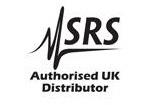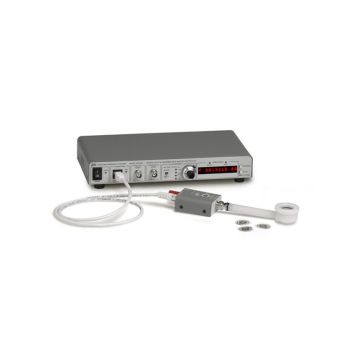SRS EC301 Potentiostat/Galvanostat
The EC301 gives electrochemists the opportunity to equip their labs with high compliance, research-grade instrumentation at a very attractive price. Stand-alone front-panel operation allows easy use in the field or in handling routine electrode preparation. The free Windows software (SRSLab) has routines for all major electrochemical experiments and can be downloaded from the SRS website.
- ±30 V compliance voltage
- ±1 A maximum current
- ±15 V polarisation range
- Front-panel setup & operation
- Free full-featured Windows software
- Built-in EIS to 100 kHz
- 1 MHz control bandwidth for EIS
- Ramps from 0.1 mV/s to 10 kV/s
- GPIB and Ethernet interfaces
Lambda Exclusive Promotion:
Additional 12 months warranty for free (2 years total) via our UK Service Centre.
Front-Panel Operation
The intuitive front panel of the EC301 allows you to quickly and easily set up several scan types (CV, LSV, steps and holds). Unlike many competitive models, the EC301 is a stand-alone instrument – you don’t need to use a computer. The array of indicator LEDs make it easy to know the state of the instrument at a glance.
Software Included
The SRSLab software supports all the major electrochemical techniques including voltammetry, pulsed waveforms, step techniques, and EIS. You can even design your own custom measurements. Data is acquired over the TCP/IP interface. The software lets you easily configure sequences of experiments and shows you the data as they are generated. The data is easily exported to spreadsheets and graphing packages.
Designed for EIS
The EC301 was designed with electrochemical impedance spectroscopy (EIS) in mind. Instead of employing driven shields, we bring the measurement close to the cell. This means higher accuracy and less susceptibility to parasitic effects. Shunt resistor current measurements in all ranges enhance control loop stability, enabling EIS at high frequencies. An external frequency response analyzer (FRA) can be used measure EIS at frequencies up to 1 MHz using analog connections. The EC301 performs stand-alone EIS measurements up to 100 kHz.
Compliance Limiting
Quite often, electrochemists are working with sensitive cells which would be destroyed if the full compliance of a potentiostat were brought to bear. Bubbles in a flow cell system can easily cause potentiostats to lose voltage control by blocking feedback to the instrument from the reference electrode. Without compliance limiting, a carefully prepared electrode will be ruined. With this feature, the user can simply select the maximum potential the counter electrode will be allowed to apply. When the limit is reached, it is clamped to the preset level. Compliance limiting guarantees safe operation even if control is lost.
Optional Power Boosters
SRS offers a ±5 A (O100BST), ±10 A (O200BST), or ±20 A (O400BST) power booster for applications requiring higher current. All three models are affordably priced.
Floating Working Electrode
In normal operation, the working electrode current return path is tied to chassis ground. However, there are times in which electrochemists wish to experiment with working electrodes that are intrinsically grounded (e.g., water pipes, rebar in concrete, an autoclave). Once the shorting bar from the rear panel of the instrument is removed, the ground return path floats, allowing these experiments.
Fast Cyclic Voltammetry
The EC301 supports scan rates up to 10 kV/s. Potential, current and an auxiliary signal are all acquired simultaneously at 250,000 samples per second. Furthermore, an AC line detection circuit allows synchronization of repetitive scans with the power line cycle.
Built-in Temperature Measurement
Temperature is a critical parameter in many battery, fuel cell and corrosion experiments, but it is often not recorded. Not knowing the temperature at which the data were acquired can make it difficult to compare your results. With a built-in input for a 100 Ω platinum RTD, the EC301 makes it easy to acquire and plot temperature right along with the rest of your data.
Open Command Set
While our software supports all major electrochemical techniques, we realize that electrochemistry isn’t static. When a new technique or procedure is developed, the open command set lets experimentalists write customized software to support it. You can write in LabVIEW, MATLAB, or any other language.
| Power Amplifier (CE) | |
|
Compliance voltage |
±30 V |
|
Maximum current |
±1 A |
|
Bandwidth |
>1 MHz (10 kΩ load, <100 µA) |
|
Slew rate |
≥10 V/µs |
|
CE limit |
Limits counter electrode voltage when enabled |
|
Set range |
±500 mV to ±30 V |
|
Bandwidth |
1 MHz |
|
Bandwidth limit |
10 Hz, 100 Hz, 1 kHz, 10 kHz, 100 kHz, 1 MHz cutoff frequencies |
|
Differential Electrometer (EC19 Module) |
|
|
Input range |
±15 V |
|
Input impedance |
>1 TΩ in parallel with 20 pF |
|
Input bias current |
<20 pA |
|
Bandwidth |
>10 MHz |
|
CMRR |
>80 dB (<10 kHz) |
|
Potentiostat Mode |
|
|
Applied voltage range |
±15 V |
|
Applied voltage resolution |
500 µV (200 µV performing an automatic scan) |
|
Applied voltage accuracy |
±0.2 % of setting ±5 mV |
|
Automatic scan rate |
0.1 mV/s to 10 kV/s |
|
Noise and ripple |
<20 µVrms (1 Hz to 10 kHz) |
| Galvanostat Mode | |
|
Applied current ranges |
±1 nA to ±1 A in decades |
|
Applied current resolution |
16-bit |
|
Applied current accuracy |
|
|
1 A range |
±0.5 % of reading ±0.2% of range |
|
All other I-ranges |
±0.2 % of reading ±0.2% of range |
|
Automatic scan rate |
1 pA/s to 2 A/s |
|
Power Booster (Opt). |
|
| Maximum current | ±5 A, ±10 A, or ±20 A |
|
Compliance voltage |
±20 V |
| ZRA Mode | |
|
Voltage offset |
CESense and WE electrodes held within ±5 mV of each other |
| Voltage Measurement | |
|
Range |
±15 V |
|
Resolution |
16-bit |
|
Accuracy |
±0.2 % of reading ±5 mV |
|
Acquisition rate |
4 µs (250 kS/s) |
|
Current Measurement |
|
|
Range |
±1 nA to ±1 A in decades |
|
Resolution |
16-bit |
|
Accuracy |
|
|
1 A range |
±0.5 % of reading ±0.2% of range |
|
All other current ranges |
±0.2 % of reading ±0.2% of range |
|
Acquisition rate |
4 µs (250 kS/s) |
|
Analog Voltage and Current Outputs (front-panel BNCs) |
|
|
Voltage output |
±15 V output |
|
Accuracy |
±0.2 % of VRE - VWE Sense ±5 mV |
|
Output impedance |
50 Ω |
|
Max. output current |
10 mA |
|
Filters |
No filtering or 10 Hz low-pass |
|
Bias rejection |
±15 V (full range) |
|
Current output |
±2 V |
|
Accuracy (1 A range) |
IWE within ±0.5 % of (VBNC x IRange) ±0.2 % x IRange |
|
Accuracy (all other current ranges) |
IWE within ±0.2 % of (VBNCx IRange) ±0.2 % x IRange |
|
Max. output current |
10 mA |
|
Filters |
No filtering or 10 Hz low-pass |
|
Bias rejection |
±2 V (full range) |
|
IR Compensation |
|
|
Positive feedback |
|
|
Range |
3 Ω to 3 GΩ (depends on current range) |
|
Resolution |
1 mΩ (1 A range), 100 kΩ (1 nA range) |
|
Current interrupt |
|
|
Switching time |
<5 µs (1 kΩ resistive load) |
|
Interrupt duration |
100 µs to 1 s |
|
Interrupt frequency |
0.1 Hz to 300 Hz |
|
EIS |
|
|
Mode |
Potentiostatic/Galvanostatic |
|
Frequency range |
1 mHz to 100 kHz |
|
Dynamic range |
120 dB |
|
Sweep |
Linear or logarithmic |
|
Temperature Measurement |
|
|
Sensor |
100 Ω Pt RTD |
|
Accuracy |
±1 °C (-100 °C to +200 °C) |
|
Rotating Electrode Output (front-panel BNC) |
|
|
Range |
0 to 10 V settable analog output |
|
Accuracy |
±1 % of setting ±5 mV |
|
External Input (front-panel BNC) |
|
|
Input range |
±15 V (potentiostat mode), ±2 V (galvanostat mode) |
|
Potentiostat mode |
1 V input corresponds to an applied voltage of 1 V |
|
Galvanostat mode |
1 V input corresponds to an applied voltage of 1 A |
|
Impedance |
10 kΩ in parallel with 50 pF |
|
Bandwidth |
>1 MHz |
|
ADD TO SCAN button |
Adds the external input voltage to internally-generated scans |
|
DIRECT CONTROL button |
Takes the control voltage or current solely from the external input |
|
Rear-Panel Inputs and Outputs |
|
|
Timebase |
10 MHz, 1 Vpp |
|
Raw E |
±15 V output |
|
Raw I |
±2 V output (1 V full scale) |
|
CE / 3 |
±10 V VCE / 3 voltage output, 1 MHz bandwidth |
|
Sync ADC |
±10 V analog input |
|
CI sync |
TTL output for IR compensation |
|
Scan trigger |
Digital input. Falling edge begins automatic scan |
| Program E/I | ±15 V input (sum of internal and external voltage programs) |
| ADC 1,2,3 | ±10 V analog inputs (general purpose) |
| SRSLab Software | |
|
Interfaces |
TCP/IP |
|
Operating system |
Windows |
|
Measurements |
Cyclic Voltammetry (CV) |
|
General |
|
|
Communication interfaces |
IEEE-488.2 and TCP/IP |
|
Dimensions |
17" × 5.25" × 19.5" (WHL) |
|
Weight |
26 lbs. |
|
Warranty |
One year parts and labour on defects in materials & workmanship |
![]() Stanford Research Systems EC301 datasheet
Stanford Research Systems EC301 datasheet
![]() Stanford Research Systems EC301 user manual
Stanford Research Systems EC301 user manual
![]() Why buying from Lambda makes sense
Why buying from Lambda makes sense
| Photo | Product | SKU |
|---|






